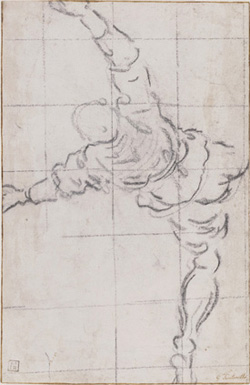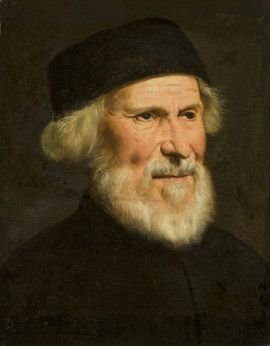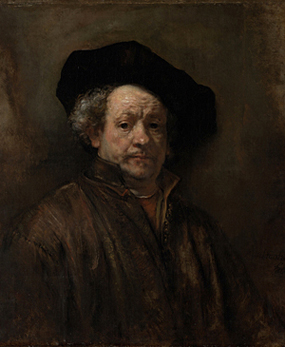Whose Venice and Whose Dutch?
John Haberin New York City
Tintoretto: Drawings and Portraits
Dutch Masterpieces at the Met
I spent a week in my twenties crossing Venice and its canals, to seek out every church with paintings by Tintoretto or Titian. For the Morgan Library, though, my task only just begun. "Drawing in Tintoretto's Venice" sees not just Tintoretto's city, but Tintoretto's century. If one has any doubts, the Met follows quickly with drawings from his studio and Tintoretto portraits. It also places its Dutch painting in a new light. 
Renaissance or Mannerist?
The Morgan begins with such precursors as Titian, whom he admired, rivaled, and hoped to leave behind. But then Tintoretto, or Jacopo Robusti, enters with a bang and never loses his dominance, even after his death in 1594—at the very moment that Caravaggio was ushering in a new era, the Baroque, in Lombardy and Rome. Named for his father's trade as a dyer, he asserts himself with thicker outlines in pen, on top of black and white chalk, and his obsession with musculature. It has not quite yet bubbled over the top, to what critics called his "bag of nuts," but he demands that it be your obsession, too. His wish to unite drawing and sculptural form continues in nearly sixty drawings after a carving that Michelangelo never completed. Many of them must have lined his workshop, and the show has a bronze cast after Michelangelo that his students may have seen as well.
The show sets him beside his star pupil at that, his son Domenico, so that no one can overlook his guidance. Figures from both lie feet first, like the dead Jesus in a painting by one of the first great Venetian artists, Andrea Mantegna. If Domenico sacrifices anatomy to foreshortening and gives the reclining figure a twist at his waist, who could match his father? It pairs the older artist, too, with perhaps his true heir, Palma Giovane. When Palma displays a heavenly Madonna over worshipful saints, their two tiers echo the manger for a Holy Family by Tintoretto thirty years before, in the church of San Rocco. A photograph with an earlier wall label helps spot the resemblance, and the Morgan for once goes well beyond its unparalleled collection, with ample loans.
Then again, this was Titian's century all along. Many a history would call anything else a falling away. Titian defined the High Renaissance in Venice, Tintoretto the late Renaissance, or Mannerism. He replaced Titian's warmth in oil with scenes seemingly struck by lightning—and Titian's anguish with pure theater. Just in case one missed the point, Europe's most famous Mannerist, El Greco, passed through Venice on his way from Crete to Spain. And the Morgan sees so strong a connection that it reassigns several drawings from Tintoretto to El Greco, for their faces pressed one against another, coils interrupting the Renaissance pyramid, and heightened emotion.
Then, too, one could make a third case—for not dominance or difference, but continuity. The High Renaissance would have had no patience for Tintoretto's chill and symmetry breaking, but it had its own concern for gesture and motion. A woodcut by Titian, of the crossing of the Red Sea, spans twelve blocks, some with no more than sweeping curves for the waves that would drown the pharaoh's armies. A sketch of entwined lovers approaches abstraction. A god in his chariot, by Andrea Schiavone, might be conducting an orchestra. Even Veronese cannot hold back, filling sheet after sheet with figure studies not far from doodles.
Tintoretto, in turn, has his conception of classicism. He did, after all, take such care for the formal training of his workshop, and he hoped to combine Michelangelo's skill in drawing with Titian's color. Never mind that the Michelangelo he liked most was on his way, too, to Mannerism. Figures twist and turn, while views from below send them in all directions. Still, they do not lack for solid outlines—and nuts. While Palma's figures almost never come anywhere near the ground, a dead Jesus in adoring arms serves as a reminder that flight would be meaningless without bodily weight.
Tintoretto has his intimate side as well, if not exactly introspective. In an oil sketch of the Holy Family, each has a role to play and proximity to the viewer. The infant Jesus looks duly commanding, John duly pious, and Mary radiant, while Joseph retains a human dignity. The light and color bring them close to the mocking of Jesus by a High Renaissance artist, Jacopo Bassano—who cares so much for humanity that he plays down the mockery. The show never can rescue Tintoretto from Titian's dominance or his own excess. Still, it takes the unknown artist who might well be El Greco to undermine once and for all the Renaissance.
Superhuman portraits
Tintoretto took seriously the task of truth to nature. He just could not be bothered with the details. His paintings leave the collective image of bodies dragged or flying across the churches and squares of Venice, even in scenes from the Bible. One might picture them as a single painting. Individuals seem almost beside the point. They can be stunning lead actors in a superhuman drama, but rarely introspective and barely human.
Yet he also painted portraits, and nine of them form the core of "Celebrating Tintoretto" at the Met. They, too, are formidable actors, but with their own limits on what they are willing and able to reveal. They make the most of piercing or sunken eyes, set against white beards and ruddy skin. All but one amount to head shots, against uncertain surroundings—and he has, often as not, been dismissed as a "face painter." The very darkest background encloses what could well be a full frontal view of Tintoretto himself, to judge by a similar face among onlookers in a religious painting and his direct engagement with the viewer. Even with his lips pressed tight, he is raging against the darkness.
As with the show's title, expect a fair degree of museum humbug. Still, the portraits, like his narrative paintings, present a collective drama. They face at different positions just off the central axis, with expressions that range from confidence to wary determination. They make good use of loose white hair and pointed beards in place of hand gestures. They accentuate eye sockets, high foreheads, nose indentations,  and chins less as anatomical studies or unified constructions than as self-expression. As in Tintoretto's larger narratives, details can move every which way and none.
and chins less as anatomical studies or unified constructions than as self-expression. As in Tintoretto's larger narratives, details can move every which way and none.
While all are loans, the Met opens with a Renaissance portrait from its collection, by Titian. It looks at first the blandest on show, half hidden behind a softly textured red beard. Yet its anxiety shows through, from the face turning cautiously away to a hand tugging fitfully at a glove, and so does the richness of oil in its background green. Tintoretto will have nothing of this, but he will just have to make do. If he seems fixated on white hair, most date from the mid-1650s, with an artist in his early thirties respectful of his elders, his patrons, and their success. Just one painting attests to his mature colors and electric highlights, with a man from at least fifteen years later in a red gown.
The show shares a single room of the Met's Lehman wing with an equal number of drawings from the collection, all but two by Tintoretto's son Domenico. For an added bit of humbug, their label as "Studio Drawings" does not mean Tintoretto in his studio, as if he were an Impressionist taking a break from nature's direct impression out of doors. It misses an opportunity compared to the artist and his circle at the Morgan Library—although drawings by the master on two sides of a sheet display his quicker, surer line and his fascination with Michelangelo. It also gets in the way of the portraits in oil, which would look more assertive on a full three sides of a room.
Still, it suggests a tempting additional story, that of an artist who never quite makes it into history, Domenico. As at the Morgan, the younger man loves foreshortened nudes, feet first, in this case all female models. One can see the artist varying the placement of their waists, butts, knees, and hands for a greater grasp of the human form and motion in three dimensions. It gets hard to say which is lying on her back as opposed to seated. The show ends with a painting of The Finding of Moses, again from the collection, leaving one to decide for oneself which Tintoretto painted it. I vote for the elder, but it is incomplete, especially in its faces, exactly opposite to the portraits—and so, I kept thinking, is the show.
Reflecting on the Dutch
As with no other artist, light for Rembrandt seems to arise from within—within a painting and within its subject. How remarkable, then, that Aristotle Contemplating the Bust of Homer is all about reflection. The philosopher is reflecting, and so is the light. It brings out his worldly and lasting fame and a wealth of materials, from his gold chain and white gown to Homer's sculpted hair, which becomes a poet's crown. The work itself has long been a showpiece, from its arrival in Messina in 1654 to its arrival at the Met in 1961, to unrivaled media attention for its time. And once again it stands apart, to open "In Praise of Painting: Dutch Masterpieces."
One need not recognize its subjects to join in the praise. Its initial owner did not, given the scant clues of a weighty pile of books behind the bust and a medallion of Alexander the Great, whom Aristotle taught, hanging on the chain. One may well, though, recognize many of the sixty-seven paintings. The museum needs a place for them while remodeling its rooms for European painting, most notably the skylights. It has already leased the Met Breuer as a kind of public warehouse while it (slowly) gets around to remodeling its galleries for modern art— and the Frick Collection will sublet that building while it remodels, too. In choosing instead the Lehman wing, as with the show's pompous title, the Met is also praising itself.
and the Frick Collection will sublet that building while it remodels, too. In choosing instead the Lehman wing, as with the show's pompous title, the Met is also praising itself.
It can get away with that, given eleven paintings by Rembrandt alone, not even counting his followers. (Far be it from me to review Dutch art of the seventeenth century, so apologies that I shall not even try apart from links to past reviews.) Besides, the work looks great. The curator, Adam Eaker, can borrow paintings from galleries devoted to a single donor that should never have stood apart in the first place, other than that money talks. The floor's eight widely spaced walls also come as a relief from the usual. The Met got its share of publicity by rehanging the European galleries barely five years earlier, but every so often it can stand a fresh light.
It also offers a peek at changing scholarship. After Aristotle, the show ditches chronology in favor of themes. A wall for "masters, pupils, and rivals" may seem to look not forward, but rather back to Romantic ideals of clashing personalities. The remaining themes look back, too, to a focus on genres. "Eloquent things" move from reminders of human transience in skulls and spilled wine to the icier still life of the late Baroque, but genres are like that. Yet the display infuses each genre with a very contemporary political correctness.
Opening wall text even apologies for not showing colonialism, slavery, war, and painting by women. Not that art overlooks a woman's work. It sees a girl asleep by Jan Vermeer, a woman peeling apples by Nicolaes Maes, or Rembrandt's portrait of his second wife as "lives of women." It sees everyday life, including wooing, as taking place "behind closed doors." It sees women themselves, including Rembrandt's Bathsheba and Bellona, as "contested bodies." Paintings may land in one or the other almost at random, but they have a point.
Politics enters the wider world with the Reformation and the war of independence from Spain. Gloriously austere church interiors by Emanuel de Witte and Hendrick van Vliet become "questions of faith" quite as much as a Holy Family by Jacob Jordaens (who, by the way, was Flemish and not Dutch)."Faces of a new nation" range from the Protestant spareness of Gerard ter Borch to the virtuoso grays of Franz Hals. And with landscapes, the show argues, that nation was "staking a claim." Somehow that includes the cloud in the shape, I could swear, of a cartoon monster by Jacob van Ruisdael, a rutted road by Meindert Hobbema, and the placid sunlit grandeur of Aelbert Cuyp—while it excludes how they measure out distance through repeated horizontals and precise observation. After so many real and scholarly wars, Rembrandt's reflections make a fitting exit.

"Drawing in Tintoretto's Venice" ran at The Morgan Library through January 6, 2019, "Celebrating Tintoretto" at The Metropolitan Museum of Art through January 27. Its hanging of Dutch painting ran through October 4, 2020.




